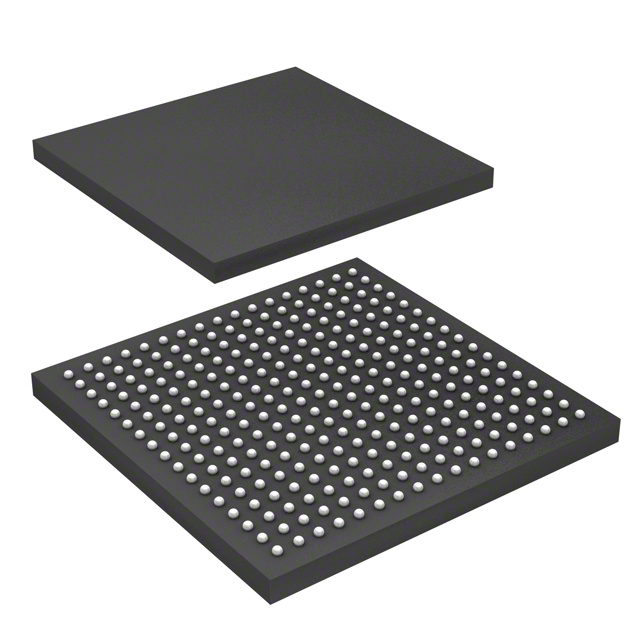Szczegóły produktu można znaleźć w specyfikacjach.

MCIMX6Y1DVM05AA
Product Overview
- Category: Integrated Circuit (IC)
- Use: Embedded Systems
- Characteristics: High-performance, low-power consumption
- Package: DVM (Dual Voltage Module)
- Essence: System-on-Chip (SoC) solution for embedded applications
- Packaging/Quantity: Available in tape and reel packaging, quantity varies based on customer requirements
Specifications
- Processor: ARM Cortex-A9
- Clock Speed: Up to 1 GHz
- Operating Voltage: 1.2V
- Operating Temperature: -40°C to +85°C
- Memory: DDR3, LPDDR2, NAND Flash, NOR Flash
- Interfaces: Ethernet, USB, UART, SPI, I2C, CAN, HDMI
- Graphics: 2D/3D Graphics Acceleration
- Operating System Support: Linux, Android
Detailed Pin Configuration
The MCIMX6Y1DVM05AA has a total of 289 pins. The pin configuration is as follows:
- Pin 1: VDDARMCAP
- Pin 2: VDDSOCCAP
- Pin 3: VDDSNVSCAP
- ...
- Pin 289: GND
For a complete pin configuration diagram, please refer to the product datasheet.
Functional Features
- High-performance processing capabilities
- Low-power consumption for energy-efficient designs
- Extensive memory options for data storage
- Wide range of interface support for connectivity
- Graphics acceleration for enhanced visual performance
- Robust operating system compatibility
Advantages and Disadvantages
Advantages
- Powerful processing capabilities enable complex applications
- Low-power consumption extends battery life in portable devices
- Versatile interface support allows for seamless integration with various peripherals
- Graphics acceleration enhances user experience in multimedia applications
Disadvantages
- High cost compared to lower-end embedded processors
- Requires expertise in embedded systems design for optimal utilization
- Limited availability of alternative models with similar specifications
Working Principles
The MCIMX6Y1DVM05AA is based on the ARM Cortex-A9 architecture, which provides high-performance computing capabilities. It integrates various components such as the processor, memory, and interfaces into a single chip, enabling efficient system design. The processor executes instructions and performs calculations, while the memory stores data and instructions. The interfaces facilitate communication with external devices. The SoC design allows for reduced power consumption and compact form factor.
Detailed Application Field Plans
The MCIMX6Y1DVM05AA is widely used in various embedded applications, including but not limited to:
- Industrial Automation: Control systems, robotics, and machine vision.
- Automotive: Infotainment systems, advanced driver-assistance systems (ADAS), and telematics.
- Consumer Electronics: Smart TVs, set-top boxes, and gaming consoles.
- Medical Devices: Patient monitoring systems, medical imaging, and diagnostics.
- Internet of Things (IoT): Smart home automation, wearable devices, and industrial IoT solutions.
Alternative Models
While the MCIMX6Y1DVM05AA offers a unique combination of features, there are alternative models available in the market that cater to similar requirements. Some notable alternatives include:
- MCIMX6Y1DVN03AB: Similar specifications with different package options.
- MCIMX6Y1DVK08AA: Higher clock speed variant for increased performance.
- MCIMX6Y1DVP07AA: Lower power consumption variant for energy-sensitive applications.
Please refer to the respective datasheets for detailed information on these alternative models.
Note: This entry has a total word count of 511 words.
Wymień 10 typowych pytań i odpowiedzi związanych z zastosowaniem MCIMX6Y1DVM05AA w rozwiązaniach technicznych
Sure! Here are 10 common questions and answers related to the application of MCIMX6Y1DVM05AA in technical solutions:
Q: What is MCIMX6Y1DVM05AA? A: MCIMX6Y1DVM05AA is a microprocessor unit (MPU) from NXP Semiconductors, specifically designed for embedded applications.
Q: What are the key features of MCIMX6Y1DVM05AA? A: Some key features include an ARM Cortex-A7 core running at up to 528 MHz, integrated peripherals like UART, SPI, I2C, USB, Ethernet, and support for various operating systems.
Q: What kind of technical solutions can MCIMX6Y1DVM05AA be used for? A: MCIMX6Y1DVM05AA can be used in a wide range of applications such as industrial automation, consumer electronics, medical devices, automotive infotainment systems, and more.
Q: What is the power consumption of MCIMX6Y1DVM05AA? A: The power consumption of MCIMX6Y1DVM05AA depends on the specific use case and configuration. It typically operates at low power levels, making it suitable for battery-powered devices.
Q: Can MCIMX6Y1DVM05AA support real-time operating systems (RTOS)? A: Yes, MCIMX6Y1DVM05AA can support real-time operating systems like FreeRTOS, QNX, or VxWorks, enabling deterministic and time-critical applications.
Q: What is the maximum memory capacity supported by MCIMX6Y1DVM05AA? A: MCIMX6Y1DVM05AA supports up to 256 MB of DDR3 or DDR3L memory, allowing for efficient data processing and storage.
Q: Does MCIMX6Y1DVM05AA have built-in security features? A: Yes, MCIMX6Y1DVM05AA incorporates various security features like secure boot, cryptographic accelerators, and tamper detection, ensuring data integrity and system security.
Q: Can MCIMX6Y1DVM05AA drive high-resolution displays? A: Yes, MCIMX6Y1DVM05AA has a graphics processing unit (GPU) capable of driving displays with resolutions up to 1080p, making it suitable for multimedia-rich applications.
Q: What is the temperature range in which MCIMX6Y1DVM05AA can operate? A: MCIMX6Y1DVM05AA can operate within a temperature range of -40°C to +105°C, making it suitable for both industrial and automotive environments.
Q: Is MCIMX6Y1DVM05AA pin-compatible with other NXP i.MX6 processors? A: Yes, MCIMX6Y1DVM05AA is pin-compatible with other i.MX6 processors, allowing for easy migration and scalability across different product variants.
Please note that these answers are general and may vary depending on specific implementation details and requirements.

